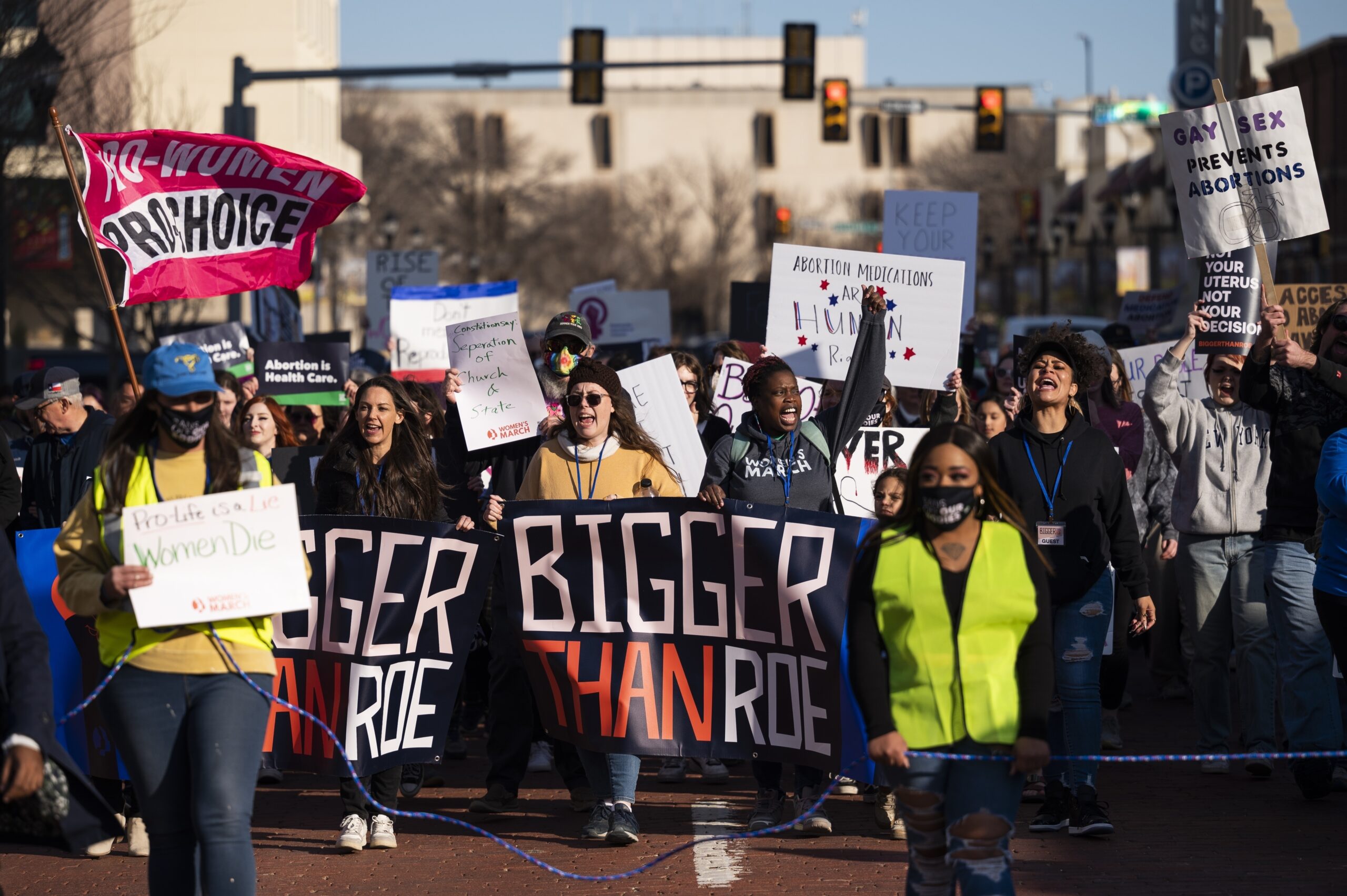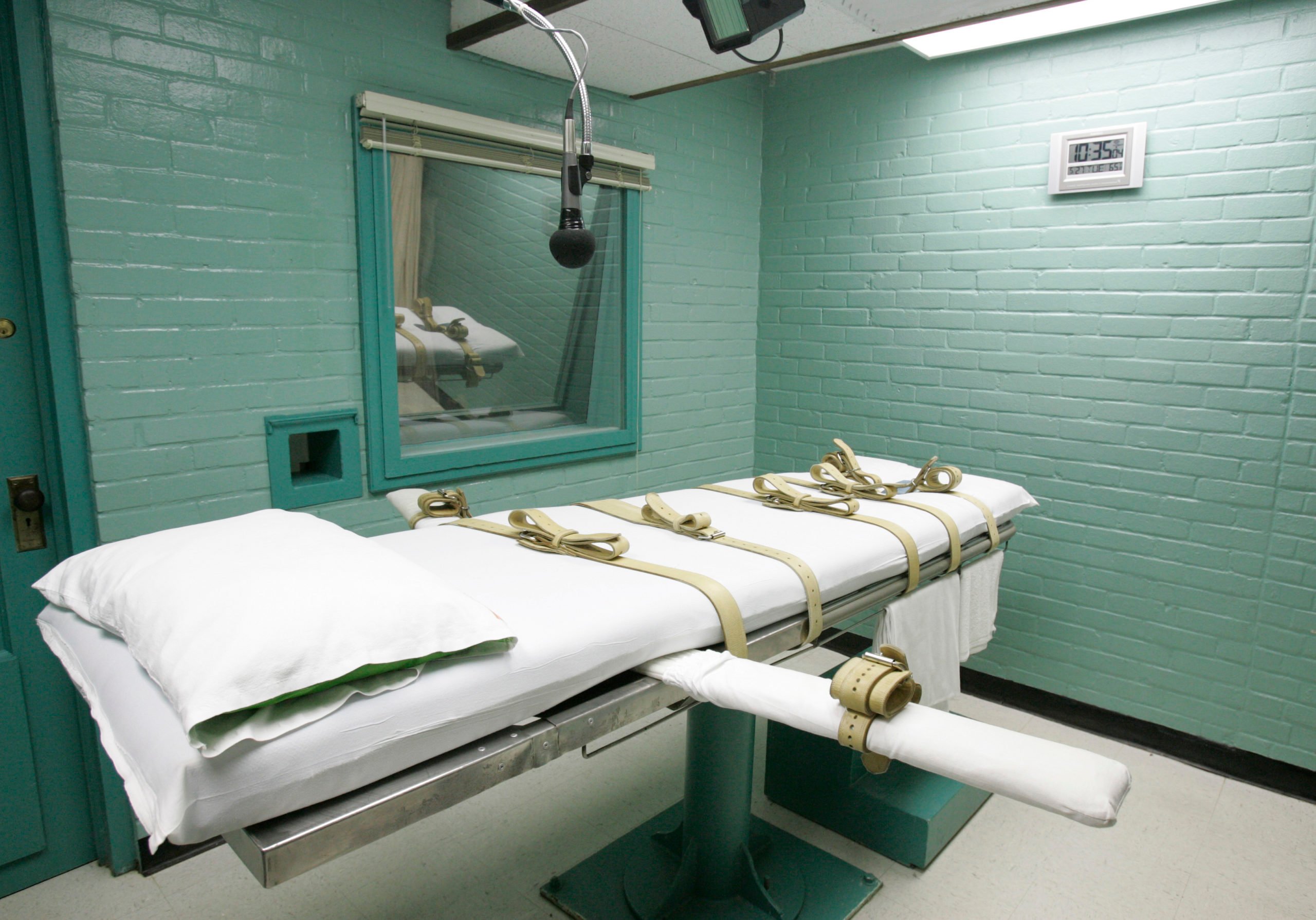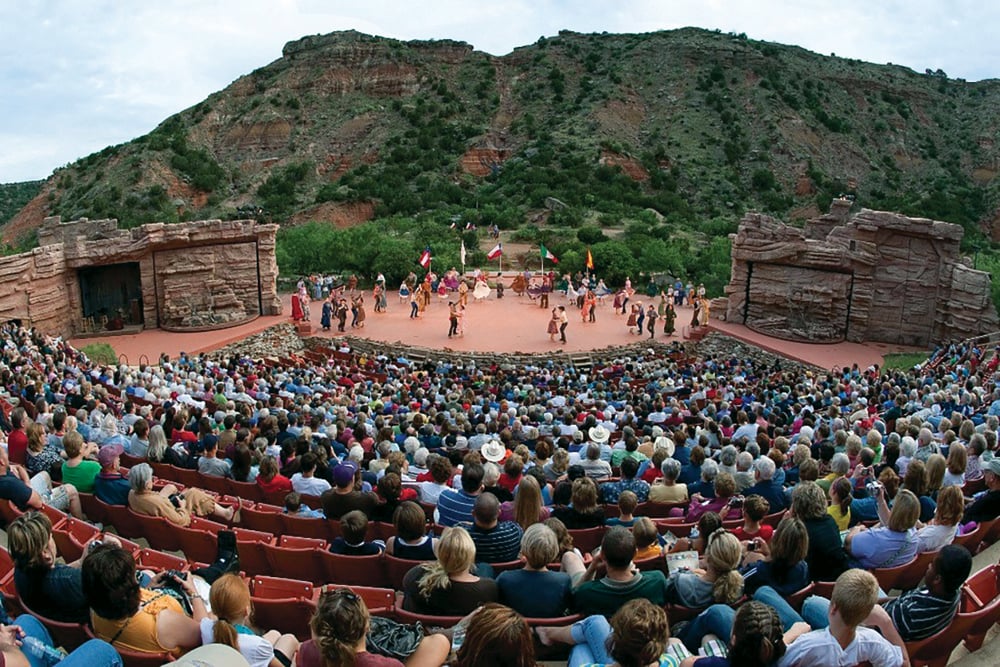
Reinventing Texas
History takes the stage in Palo Duro Canyon
A version of this story ran in the July 2015 issue.
By the time the trumpet opens the show with its first eight notes, the herds of buffalo on the southern plains have already been killed. The Comanches have surrendered and gone to the reservation in Oklahoma. The fencing and settling of the great Texas rangelands has begun.
Meanwhile, the actors have donned their costumes: bustles, bloomers, cowboy hats and character shoes. The horse wranglers have gathered in a circle for a prayer. Sixty young performing artists have spent nearly three weeks together in rehearsals running for up to 12 hours a day, seven days a week.
As the notes linger in the cool air, a lone rider gallops along the canyon rim 600 feet above the stage carrying a Texas flag. The cast and crew cheer—this is the first time the iconic rider has been added to rehearsal. By the time the finale ends nearly two and a half hours from now, the sun will have set, the boy will have gotten the girl, the cattlemen and farmers will have achieved a tenuous truce and the railroad will have arrived in the Panhandle.
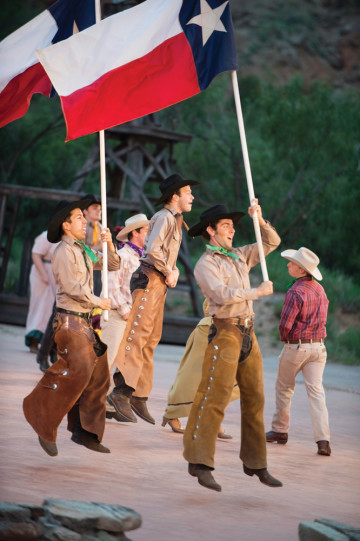
It’s almost opening night of the 50th season of the outdoor musical Texas. Performed in the 1,600-seat Pioneer Amphitheatre in Palo Duro Canyon State Park, the show is a staple of the summer economy in Canyon, population 13,000, located 14 miles south of Amarillo. Texas fills the hotel rooms and pumps life into the restaurants and apartment complexes that West Texas A&M University students abandon between semesters. It provides summer jobs for performing artists in the Panhandle, including professionals from Lubbock, Plainview, Canyon and Amarillo. Several of its directors, along with their children and spouses, have been with the show for years. The company is often described as a family.
In its heyday, in the 1970s and ’80s, Texas drew more than 100,000 patrons a year to the canyon. Those numbers have since fallen, though with 58,000 tickets sold in 2014, Texas is still the best-attended outdoor history drama in the nation.
But the show is more than a tourist attraction. It’s a community ritual, an annual affirmation of Panhandle citizens’ perseverance in the face of hardship, told through a fictionalized history of their region. The play depicts a debate over the nature of progress in the Panhandle, even as the production itself has been forced to evolve.
The sun begins to slip behind the canyon rim, sending the stage into shadow. Swallows dart across the amphitheater’s expanse of empty seats. The chorus and dancers cluster in the wings, poised for their cue, then run onto the stage whooping and shouting. The opening medley begins: “We invite you all to come to Texas!”
The business side of Texas is run by the nonprofit Texas Panhandle Heritage Foundation, which was established when the show was created in the 1960s. Its current executive director, Kris Miller, was “a skinny little dancer” in the show in the 1970s and went on to a career as a booking agent in Dallas and manager of the Amarillo Civic Center. Now more Santa-like than skinny, Miller still gets stage time, portraying crusty gold prospector Tucker Yelldell.
While planning and fundraising are year-round jobs, the performance is assembled over three breakneck weeks in May. Returning cast make the process easier. Brian Kuhnert, director of opera and musical theater studies at Wayland Baptist University in Plainview, has played a lead role, Colonel Henry, for nine years. Henry’s wife, Aunt Anna, is played by Cloyce Kuhnert, an associate professor of voice at West Texas A&M who has been in the cast for 24 years and also serves as the production’s music director and costume designer. (The two are married offstage as well.) To fill open positions, Artistic Director Dave Yirak, Ms. Kuhnert and the show’s choreographer, Crystal Bertrand, an instructor of dance at West Texas A&M, attend auditions throughout the spring, choosing from roughly 1,000 performers at events in Canyon, Houston, Oklahoma and Tennessee.
Rehearsals start at 1 p.m. on the West Texas A&M campus; in the evening, the company moves to the canyon, 12 miles east of town. Because Yirak’s other job is teaching high school theater in Canyon, he gets Don Williams, a theater professor and director of graduate studies at Hancock College of Liberal Arts and Education at Lubbock Christian University—and Yirak’s former college professor—to help with daytime rehearsals.
This afternoon Williams is running the chuckwagon scene, switching between its musical number (an adaptation of Woody Guthrie’s “I Ride an Old Paint”) and its dialogue between two leads. Men in the chorus portraying cowboys sprawl before an imaginary chuckwagon, chatting and joking as Williams works with the actors.
“I know we start to have subplots developing between the cowboys,” he tells them at the end of rehearsal. “Try to keep those subplots subdued.” The acoustics in the amphitheater, he explains, are so good that their onstage whispers will travel.
The production is the first professional experience for many performers, and it doesn’t disappoint. The long run of 65 performances means cast and crew develop close friendships and professional connections. Performers expand their résumés by learning to ride horses and execute pyrotechnic stunts. And the amphitheater itself is a draw.
“There are times when you look around and see the canyon where you’re actually performing and just get blown away,” says Austin Harleson, 22, a chorus member. “Especially in the chuckwagon scene, when I look up at the stars.”
Offstage, cast and crew are embraced by the Canyon community.
“I love seeing how much pride the people of Canyon have in the show,” says Libby Dowell, a chorus member who hails from Washington, D.C. “I’m an outsider to the area, but all I have to say is that I’m a canyon performer, and all of a sudden it’s, ‘Oh, how’s the show going?’ Everyone’s cordial and kind.”
“Hey, we’ve got cowboys and Indians, but we’ve got people doing triple pirouettes at the same time.”
According to a 2009 study conducted by Texas Perspectives Inc. for the Texas Cultural Trust, Texas and related tourism spending had a $17.5 million impact on the regional economy. The show is part of an arts scene that includes Amarillo’s symphony, opera, little theater, chamber music ensemble, ballet and a 9-year-old, $30 million performing arts center.
Texas alumni have gone on to perform on Broadway and around the world.
Given that context, performers say, outsiders shouldn’t assume that the Panhandle’s remoteness translates into lack of culture. Amarillo native J.T. Sherrer, 23, a professional entertainer at Walt Disney World who plays ranch hand Dude Forbes in Texas, describes the show as “a cool way to say, ‘Hey, we’ve got cowboys and Indians, but we’ve got people doing triple pirouettes at the same time.’”
The story is set in the late 1880s, as the Panhandle plains—“where you can look farther and see less than anywhere else on earth,” as Tucker Yelldell laments—are being settled and conflicts are erupting between cattlemen and farmers over the use of public lands. Its characters are fictional composites, though most agree that the lead role of Colonel Henry is roughly based on legendary rancher Charles Goodnight. As the show opens, aspiring farmer Calvin Armstrong returns to the Panhandle after the deaths of his parents. His plans to bring a railroad to the area meet resistance from Colonel Henry, who worries the track will cut through his cattle pastures, and from Colonel Henry’s younger foreman, Dave Newberry. The conflict between Calvin and Dave is exacerbated by the arrival of Henry’s attractive niece, Elsie McLean. As an ongoing drought intensifies, Calvin falls sick, Henry has nightmares about fires and losing his land, and Elsie returns to her home in St. Louis. A good rain and the placating decision to name the new town Henrianna after Colonel Henry and his wife, Anna, set everything right, and the appropriate couples get married.
Today’s Canyon neighborhoods are a far cry from the dugouts where the early white Panhandle settlers lived, and air conditioning makes the worst heat bearable. But the region is still subject to extreme weather: wind, fire, hail, tornadoes, blizzards and drought.
“Everything that you hear about in this show, we’ve suffered through it,” says 70-year-old Joe Batson, a longtime donor to the Texas Panhandle Heritage Foundation who’s been involved with Texas since its inception. “It really does tell a microcosm of life in the Panhandle.”
The idea for a show that would instruct successive generations about that heritage started in 1960 with Margaret Harper, a civic leader in Canyon and the wife of Ples Harper, a professor at West Texas State College, now West Texas A&M. Ms. Harper found herself perplexed by three situations: The stunningly beautiful canyon—the second-largest in the country—attracted few tourists; the businesses in Canyon struggled every summer when the students and faculty left; and, she later told a historian, she lamented “how difficult it is for people to comprehend the past and its influence upon the present.”
Harper read an article in Reader’s Digest about playwright Paul Green, who had written several popular historical musicals—he called them “symphonic dramas”—that were performed in outdoor theaters. Maybe the town should get Paul Green to write a musical for Palo Duro Canyon, she thought, and solve all three problems at once. Harper wrote to Green, who replied within two weeks and later visited the canyon. He brought with him John Parker, the business manager of his first outdoor musical in North Carolina, to evaluate the major highways, existing tourist attractions and availability of hotel beds in the region. As Harper and others raised funds and formed the Texas Panhandle Heritage Foundation, Green began studying the area’s history. By 1966 both the amphitheater and the script were finished, and Texas opened on July 1.
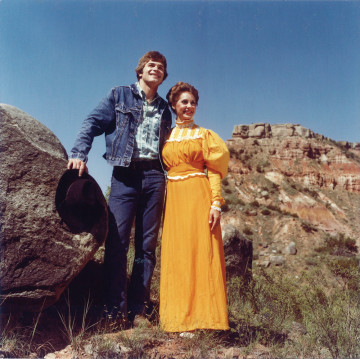
“Some in the community thought it was a great idea, and some thought it would never work in an area so sparsely populated,” says Neil Hess, Texas’ original choreographer, who served the production in various capacities for 35 years and now lives in South Carolina.
Born to poor North Carolina farmers in 1894, Paul Green taught philosophy and drama at the University of North Carolina at Chapel Hill while writing for both Broadway—winning a Pulitzer for In Abraham’s Bosom in 1927—and Hollywood. A supporter of racial equality and opponent of the death penalty, he was drawn to the struggles of common people and railed against the sex, violence, and what he called “cheap material” in many movies. He became absorbed with Greek theater and “the role of the playwright in building civilization,” a role he saw as his own. His left-leaning views about that ideal civilization at times generated friction with Texas organizers.
“He really believed in theater for the people,” says Marsha Warren, executive director of the Paul Green Foundation, which awards grants to projects focused on arts and human rights. “He wanted the regular, everyday people, who maybe don’t feel comfortable going into a theater or don’t have the money for it, to go into the outdoors and see these plays.”
Margaret Harper later recalled asking Green why, when he received so many invitations to write regional history plays, he’d agreed to come to the Texas Panhandle. “He felt that he would like to write a play about a period in our society that portrayed stubbornness, tenacity and struggle,” she said, “and our story could illustrate these elements better than most.”
While Texas does convey struggle, it takes some liberties with historical fact. Most people agree that Colonel Henry’s opposition to the railroad is a bit of a head-scratcher, since the railroad enabled cattlemen to convey their herds to northern markets without the risks inherent in long trail rides. The original script includes a party scene that is interrupted by Comanche Chief Quanah Parker and his dying father, Nokoni, who are visiting from the Oklahoma reservation in the 1880s. In reality, Parker’s father died in 1860.
Over the years, directors made minor adjustments to the show, but all changes had to be vetted by Green or, after his death in 1981, his literary executor. Directors’ inability to make major modifications, as well as an attempt to pull attendance out of a slump, led the foundation to set aside Texas in favor of a new, more historically accurate script called Texas Legacies that was written by local playwright Lynn Hart and performed in the canyon from 2003 to 2005.
“Everything that you hear about in this show, we’ve suffered through it. It really does tell a microcosm of life in the Panhandle.”
Legacies scrapped the composite characters of Texas and gave a more fact-based portrayal of history. One of that show’s episodes followed the 1874 battle of Palo Duro Canyon, in which U.S. Col. Ranald Mackenzie captured more than a thousand Comanche horses. Knowing the Comanches’ strength lay in their horsemanship, and unable to appropriate the enormous herd himself, Mackenzie set aside the best animals and ordered his men to shoot the rest.
Legacies depicted the incident with sound effects of horses screaming and bloodlike red light trickling down the canyon wall. But audiences were not ready for A People’s History of the Panhandle, and the show didn’t catch on. As Texas Panhandle Heritage Foundation board member Marsha Clements says, “If you want to read about that, read about it. You don’t want to watch somebody sing and dance about it.”
Betty Propst, the Texas Panhandle Heritage Foundation’s development director since 1978, has another theory: Panhandle residents feel an ownership of Texas they didn’t feel about Legacies.
“Especially to a Texan, it’s like spitting on the pope” to change the show, she says. “‘Don’t mess with Texas’ musical drama.’ We tried that, and they about ran us out of town. They wanted their Texas back.”
So the foundation gave it to them, though the process was complicated. The 1966 agreement between Paul Green and Margaret Harper stated that Texas had to be performed—and the accompanying royalty payments made—with a particular frequency, or the Texas Panhandle Heritage Foundation would lose its performing rights. The Paul Green Foundation saw the Panhandle foundation’s decision to shelve Texas for Texas Legacies as a breach of contract. When the Green foundation moved to end its contract with the Panhandle foundation, the latter sued; the Green foundation countersued. The groups settled in 2003, with the Green foundation selling Panhandle Heritage the rights to the Texas script for $300,000. When Legacies was shelved and Texas was restored to the stage in 2006, Panhandle Heritage artistic staff had the liberty to make whatever changes they wished.
The lawsuits haven’t been the show’s only offstage drama. In 2001, the foundation dismissed longtime artistic director Hess, and several other artistic staff resigned in protest. Hess went on to start an outdoor Texas history musical called Lone Star Rising that ran for five seasons at the Fritch Fortress Amphitheater in Lake Meredith National Recreation Area, 34 miles northeast of Amarillo. Later, in 2009, a majority of the foundation’s board fired its executive director, and five other board members immediately resigned.
More recently, the leadership has remained stable, with Yirak serving as artistic director for 10 years and Miller as executive director for four. Yirak has tinkered with the show to expand a few of the minor roles and add the show’s first Hispanic characters, Diego and Isabella, betrothed as children in Mexico and reunited years later in the Panhandle. He has also reworked Quanah Parker’s scene, deleting the death of his father. In Yirak’s update, Quanah arrives alone, having recently taken his people on a government-sanctioned buffalo hunt and having found only the bones of buffalo killed by white men. “The great animals who gave life to my people since time began are gone,” he announces. “I am told we must change and live with the white man in his world. But I see the hate in the eyes of your people and I know the hate in the hearts of my people, and I ask how this can ever be.”
Yirak also consulted with Benny Tahmahkera Jr., a great-great-great grandson of Quanah Parker, about adding Comanche greetings to the script. Tahmahkera, a retired Marine with two degrees in Native American studies, has portrayed Parker onstage for three years and says the show’s depiction of Comanches is fair. He dresses in his Comanche regalia and gives a presentation about Comanche history and culture before the show.
“I get asked on a daily basis if I live in a tepee, or if I still ride a horse,” he says. “I say, ‘No, we’re just like you. We’ve assimilated over the years. We want the same things—education, health care. The only thing that’s different is we have our own culture and language we try to keep alive.’”
Because of Tahmahkera’s involvement with the show, members of the Comanche Nation have driven the four hours from their homes in Lawton, Oklahoma, to Palo Duro Canyon to see performances. They’re likely the only audience members who understand Quanah’s greetings or a recording of a Comanche hymn played during a dream sequence. They sometimes sing along.
Yirak has even changed the script to help the company recover from a tragedy. In August 2013, five cast members were killed and another seriously injured in a car accident after a cast party. The driver, a performer, had been drinking. The company decided to finish the season’s last four performances, and Yirak commissioned a friend to write a song that would embody healing and perseverance. Act 2 now opens with “West Texas Rain”:
There’s always a cloud in the distance it seems
But behind it the sky is still blue as can be
(and) Tonite the angels are ridin’ in
On the back of a West Texas Rain.
Canyon native Marissa Hernandez, who was a child actor in the show for 10 years and has been in the chorus for two, says the song is significant to those who knew the deceased cast members, but it also has a universal message. “The whole show has a theme of, ‘We’re in a drought,’ and then we sing that song about rain,” she says. “It’s once again speaking to the faith and the perseverance that the pioneers of this area had, and really sticking it out when things got rough.”
Texas’ directors have also made strategic changes to attract new audiences. For the past few years the show has concluded with the “grand finale,” a crowd-pleasing non sequitur involving patriotic songs and fireworks. In 2011, drought forced the team to scrap the fireworks, so they installed a choreographed fountain performance called “The Dancing Waters of Texas.” An Act 2 dream sequence called the “fire ballet” now includes a performer actually being set on fire—a dramatic stunt that involves extensive training, cooling gel, a special suit and an offstage bucket of water. For many years, the first act has ended with an explosion of lightning and thunder, a special effect created with a 450-foot length of military-grade detonating cord that stretches from a tree behind the stage partway up the canyon wall.
Such embellishments help Executive Director Miller market the show. In the early days, tour buses filled the parking lots—Hess remembers groups from England, Germany and China—but while tour groups still come, the bus-tour business is smaller than it used to be. Miller’s current strategy is to appeal to Panhandle residents. “We’re trying to get the locals that haven’t seen the show, or haven’t seen it in a while,” to come and bring family and friends, he says. “The catch line is, ‘You may have seen Texas, but you’ve never seen Texas like this.’”
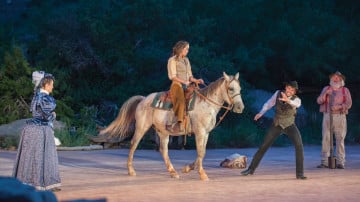
It’s a good strategy, says Michael Hardy, director of the Institute of Outdoor Theatre in North Carolina. The association advises the handful of companies that still present a few of Paul Green’s symphonic dramas, along with hundreds of passion plays, Shakespeare festivals and Broadway musicals. Outdoor theater’s popularity peaked from the 1970s through the 1990s and has declined since 2000. Ticket sales dropped most for historical and religious dramas, even as they’ve risen in other genres, including Shakespeare festivals. Texas has followed a similar pattern, boasting more than 100,000 annual ticket sales in the ’70s and ’80s, but dropping to less than half that pre-Texas Legacies. Since the original show was restored, attendance has crept back up to the highest of the institute’s 15 reporting history dramas.
“They’ve been very smart about coming up with new stuff that would be appealing,” Hardy says. “All the history dramas are typically shows that were written 50, 60, 75, even 90 years ago, and entertainment standards have changed so much. And the competition for the entertainment dollar” has gotten much more intense, whether from Disneyland, Six Flags and other theme parks, cable television, Netflix, the Internet—the list goes on.
Outdoor drama’s popularity in the 1970s was partly a result of renewed interest in American heritage connected with the country’s bicentennial celebration. Texas continued to ride that wave as it approached its own sesquicentennial in 1986. In 1979, the Legislature recognized four outdoor dramas as the official state plays of Texas: Paul Green’s The Lone Star, which depicts the 1836 battles for Texas independence and was performed in Galveston; Beyond the Sundown, which portrays the Alabama-Coushatta tribes’ reactions to the 1836 battles; Fort Griffin Fandangle, which is still staged every summer by the citizens of Albany; and Texas.
Going forward, Miller, Propst and the staff are always looking for new audiences and new sources of revenue to fill out the show’s $2.5 million annual budget. Ticket sales aren’t enough, and it’s not clear that a younger generation is willing or able to supplant the current donor base, Propst says. She’d like to create a new attraction by transforming the patio area outside the amphitheater into the play’s town of Henrianna, complete with costumed interpreters. Batson suggests building an extension of Canyon’s Panhandle-Plains Historical Museum near the theater, or a history-themed water park that would offer the only place to swim in the canyon.
But ticket sales have been good so far this year, Miller tells his board at a quick meeting at the amphitheater while rehearsal is in progress. One weekend that’s selling well is July 17-19, which features a reunion for the show’s more than 4,000 alumni. Sales are up 30 percent over this time last year, though it’s too early to know whether they’ll reach Miller’s goal of 70,000 attendees this season.
Considering the casual orientation of contemporary Texas culture, it’s surprising the show isn’t more popular. Despite some anachronistic and kitschy elements, the production offers exposure to nature and a friendly, unpretentious atmosphere.
“It’s such a sincere piece of theater,” he says. “It doesn’t try to be anything other than what it is: a love story, Americana, a spectacle.”
“There’s nothing elite about outdoor theater,” says Hardy. “Even in Shakespeare … you get a lot of families, kids, maybe even dogs running around. It’s a more relaxed, democratic kind of environment.”
And Texas has a refreshing simplicity that appeals to Luke van Meveren, a Minnesota native and chorus member who’s in graduate school at Texas Tech University in Lubbock. Backstage, he catches his breath after performing the burn stunt and changing back into his costume.
“It’s such a sincere piece of theater,” he says. “It doesn’t try to be anything other than what it is: a love story, Americana, a spectacle. And it’s one of those things that you don’t get to do in theater very often. In a lot of shows, it’s like, ‘All right, hmm, we really need to think hard. What’s the concept of this going to be?’ And here we’re just like, ‘Let’s blow up a tree.’”
He’s referring to the play’s famous lightning bolt, which will get a test run at tomorrow night’s rehearsal. It’s nearly 11 o’clock, and as soon as the performers run through the finale, they’ll be dismissed. A real thunderstorm has been building in the distance, and a fine, light rain dampens the dancers’ hair. Between the flashes of genuine lightning, the stars hang low and luminous in the night sky—“close enough,” as the hero Calvin Armstrong says, “for a man to reach up and gather a hatful of them.”
